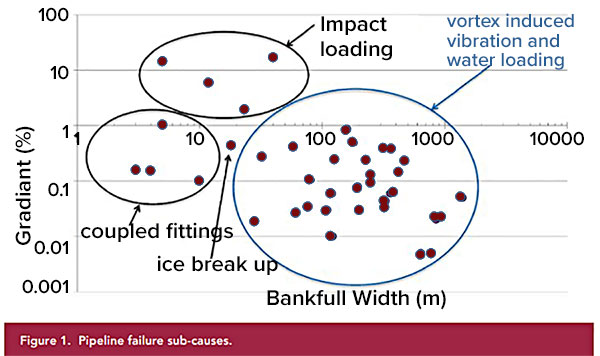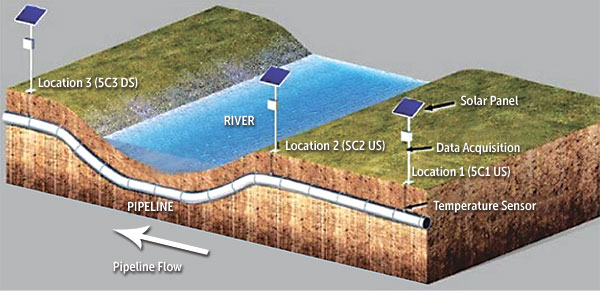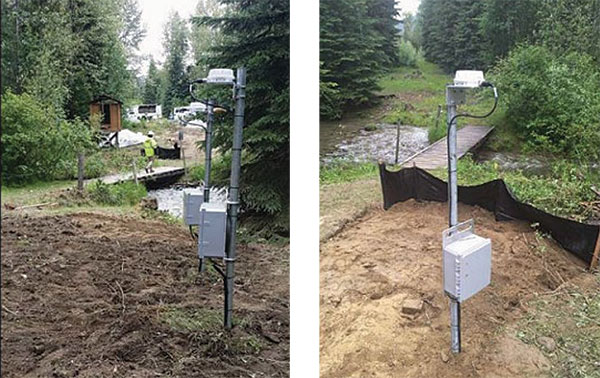December 2022, Vol. 249, No. 12
Features
Identifying Pipeline Exposure via River Scour Monitoring Technology
By Rebecca A. Bickham, Materials Performance Editor, AMPP
(P&GJ) — Erosion and scouring, among other sources, can lead to pipeline exposure when pipelines cross bodies of water. Even if these pipelines were adequately covered at one time, they are at risk for partial or full exposure due to water actions.
Lakes, ponds, rivers, swamps, etc., that cross pipes cause loading from water pressure, moving objects in the water and sometimes cyclical vortex-induced vibration, which are all known causes of pipeline failure. Once exposed, pipeline coatings are at additional risk from third-party events or ultraviolet damage.
To avoid pipeline operator liability and to keep people, the environment and related resources safe from events such as erosion, scour, dredging, debris and floatation, it is important to follow applicable regulations and codes.
An advisory bulletin released by the U.S. Pipeline and Hazardous Materials Safety Administration encouraged owners and operators to implement corrective actions, like inspections, after a water event. In addition to inspections, monitoring and autonomous surface vehicles can be of aid.
River scour occurs when moving water erodes a riverbed/riverbank, either progressively (with time) or abruptly (from a flood). River scour monitoring (RSM) systems, using temperature sensing, have proven effective in detecting exposed pipe and the degree of pipeline scour.
Identifying scour early is key because once a pipeline is uncovered, it can be damaged in multiple ways.
By analyzing two case studies, researchers V. Shankar, C. Onuoha, E. Pozniak, S. McDonnell and M. Jawed of PureHM (Nisku, Alberta, Canada) offer “easy, effective, and consistent methods to identify and verify an exposed pipeline in a watercourse crossing” in their CORROSION 2020 paper.1
Because finding failures during a flood or other event is difficult and unlikely, remote monitoring systems can be invaluable due to the real-time information they offer. Figure 1 shows pipeline failures from water actions, along with the sub-cause of each and the ideal RSM system (Figure 1).
It is vital to establish baseline conditions prior to setting up the RSM system. Any changes can be identified this way. Baseline measurements should include the following:
In the first case study, the researchers validated the technology on a pipeline at two creek crossings (North Crossing and South Crossing). Three sensors, each with a temperature sensor and an acoustic sensor, were positioned at each crossing — two upstream and one downstream (Figures 2 and 3 ).
In the study, the sensors were externally charged at three-month intervals, but recent systems have since been updated with solar panels. Data are collected in real time and communicated to analysts via satellite for review.
The study revealed that no exposed pipe occurred at the North Crossing. Using the temperatures recorded on both upstream sensors and calculating the rate of change, the researchers forecasted the temperature at the downstream end.
Assessing the predicted vs. actual temperatures showed no deviation, and a visual inspection confirmed there was no pipe exposure.
However, the South Crossing did result in pipe exposure. This time, when actual and predicted temperatures were compared, they revealed a considerable difference.
Visual examination revealed the exposure. This substantiated the technology’s ability to correctly identify exposed pipe at water crossings.
The scientists emphasize that product flow is a foremost prerequisite to properly use this technology because, “The measured temperature on the pipeline is primarily due to the product, and rate of change of temperature is due to the product flow from one location to another and thermal equilibrium between pipe, soil, and water.”1
Pipe exposure also occurred in the second case study, in which an indirect inspection survey validated the exposure. After extensive flooding was observed on-site, a bathymetric survey was conducted. M2B sonar mounted on a boat revealed 68 feet (20.7 meters) of exposed pipeline.
A “touchdown point” identified in the middle enabled the researchers to reduce the length to two smaller sections – one 16 feet (4.88 meters) and one 36 feet (10.97 meters).
Managing pipelines at water crossings using RSM technology can reduce contamination, save lives and prevent damage to the environment.
By incorporating RSM technology, integrated direct inspection technology, plus autonomous surface vehicles, operators have successful, reliable information with which to validate exposed pipe.
Editor’s note: This article first appeared in Materials Performance, an AMPP publication.
Reference:
1V. Shankar, C. Onuoha, E. Pozniak, S. McDonnell, M. Jawed, “Monitoring and Assessing Pipeline Water Crossings in the Face of Severe Flooding, River Scour, and River Channel Migration,” CORROSION 2020, paper no. NACE-2020-14962 (Houston, TX: NACE International, 2020).








Comments